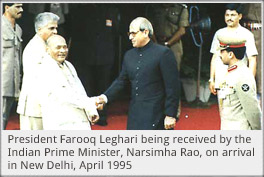As a result of the general elections in 1993, P. P. P. came to power by forming an alliance with P. M. L. (J), some independent members and some small parties. After the formation of the Governments at the Center and in the provinces, the next step was the election of the President. Initially, a number of candidates filed their nomination papers. However, as election day approached, there were only two candidates left in the field. These were the acting President Wasim Sajjad, a nominee of the P. M. L. (N), and Sardar Farooq Leghari, a nominee of the P. P. P. As a result of voting, Leghari got 274 votes in his favor against 168 votes for Wasim Sajjad. On November 13, 1993, Sardar Farooq Leghari was appointed as the President of Pakistan for a term of five years.
Leghari began his term with a clean reputation, but this was soon to change with the Mehran Bank scandal and inappropriate appointments in the judiciary. In his first speech, Leghari had said that the Eighth Amendment would be removed but during the term of Benazir, no bill was ever presented to do away with this Article of the Constitution.
 Differences emerged between Benazir and Leghari, which eventually resulted in the President using the Eighth Amendment for the dissolution of the National Assembly, and the dismissal of Benazir. When Mian Nawaz Sharif was re-elected as the Prime Minister, differences arose between them. He supported the Chief Justice of Pakistan, Sajjad Ali Shah, who had also developed serious differences with the Nawaz Sharif Government. But Leghari could not overcome the heavy mandate that was bestowed upon Mian Nawaz Sharif by the public, with the result that he had to resign on December 2, 1997. Farooq Leghari’s resignation brought to an end the tragic drama of conflict and conspiracy between the Judiciary, the Executive, and the Legislature. His resignation cut short his term as the President for five years by nearly one year.
Differences emerged between Benazir and Leghari, which eventually resulted in the President using the Eighth Amendment for the dissolution of the National Assembly, and the dismissal of Benazir. When Mian Nawaz Sharif was re-elected as the Prime Minister, differences arose between them. He supported the Chief Justice of Pakistan, Sajjad Ali Shah, who had also developed serious differences with the Nawaz Sharif Government. But Leghari could not overcome the heavy mandate that was bestowed upon Mian Nawaz Sharif by the public, with the result that he had to resign on December 2, 1997. Farooq Leghari’s resignation brought to an end the tragic drama of conflict and conspiracy between the Judiciary, the Executive, and the Legislature. His resignation cut short his term as the President for five years by nearly one year.
This article was last updated on Sunday, June 01, 2003






